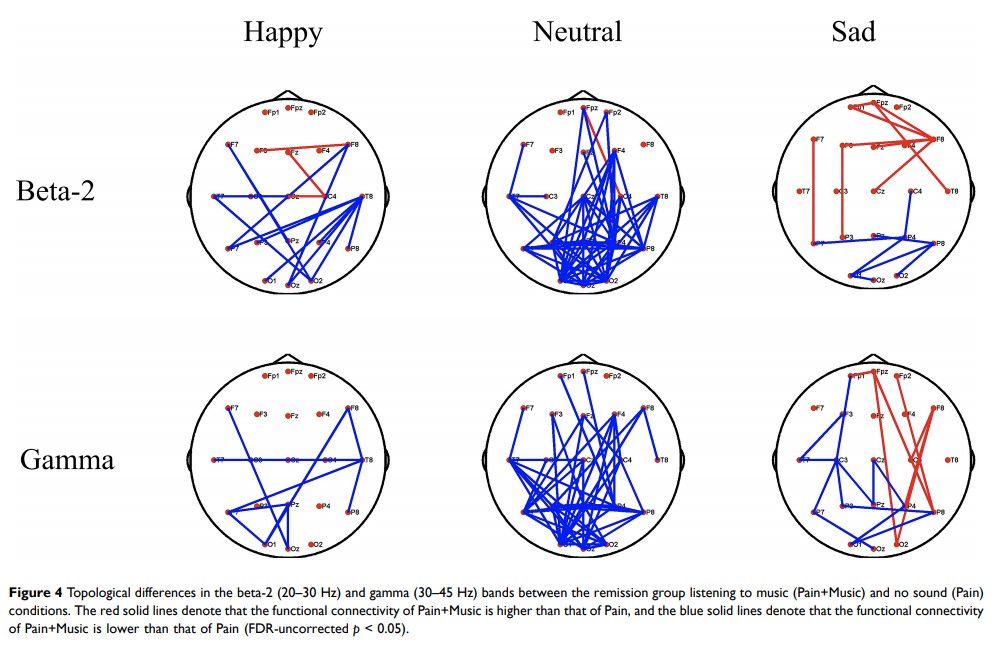9 7 8 1 6
论文已发表
注册即可获取德孚的最新动态
IF 收录期刊
- 3.3 Breast Cancer (Dove Med Press)
- 3.4 Clin Epidemiol
- 2.5 Cancer Manag Res
- 2.9 Infect Drug Resist
- 3.5 Clin Interv Aging
- 4.7 Drug Des Dev Ther
- 2.7 Int J Chronic Obstr
- 6.6 Int J Nanomed
- 2.5 Int J Women's Health
- 2.5 Neuropsych Dis Treat
- 2.7 OncoTargets Ther
- 2.0 Patient Prefer Adher
- 2.3 Ther Clin Risk Manag
- 2.5 J Pain Res
- 2.8 Diabet Metab Synd Ob
- 2.8 Psychol Res Behav Ma
- 3.0 Nat Sci Sleep
- 1.8 Pharmgenomics Pers Med
- 2.7 Risk Manag Healthc Policy
- 4.2 J Inflamm Res
- 2.1 Int J Gen Med
- 4.2 J Hepatocell Carcinoma
- 3.7 J Asthma Allergy
- 1.9 Clin Cosmet Investig Dermatol
- 2.7 J Multidiscip Healthc

悲伤的音乐可调节疼痛知觉:一项脑电图研究
Authors Guo S, Lu J, Wang Y, Li Y, Huang B, Zhang Y, Gong W, Yao D, Yuan Y, Xia Y
Received 26 May 2020
Accepted for publication 23 July 2020
Published 7 August 2020 Volume 2020:13 Pages 2003—2012
DOI https://doi.org/10.2147/JPR.S264188
Checked for plagiarism Yes
Review by Single anonymous peer review
Peer reviewer comments 3
Editor who approved publication: Dr Michael Schatman
Background: Music has shown positive effects on pain management in previous studies. However, the relationship between musical emotional types and therapeutic effects remains unclear. To investigate this issue, this study tested three typical emotional types of music and discussed their neural mechanisms in relation to pain modulation.
Subjects and Methods: In this experiment, 40 participants were exposed to cold pain under four conditions: listening to happy music, listening to neutral music, listening to sad music and no sound. EEG and pain thresholds were recorded. The participants were divided into the remission group and the nonremission group for analysis. Differences among conditions were quantified by the duration of exposure to the pain-inducing stimulus in the remission group. EEG data were obtained using a fast Fourier transform (FFT) and then correlated with the behavioral data.
Results: We found that sad music had a significantly better effect on alleviating pain, as a result of brain oscillations in a higher beta band and the gamma band at the O2 and P4 electrodes. The comparison between the remission group and the nonremission group suggested that personality may affect music-induced analgesia, and dominance, liveliness and introvert and extrovert personality traits were associated with pain modulation by sad music. Additionally, in the network analysis, we compared brain networks under the three conditions and discussed the possible mechanisms underlying the better analgesic effect of sad music.
Conclusion: Sad music may have a better effect on alleviating pain, and its neural mechanisms are also discussed. This work may help understand the effects of music on pain modulation, which also has potential value for clinical use.
Keywords: pain, music-induced analgesia, personality, EEG, brain network
